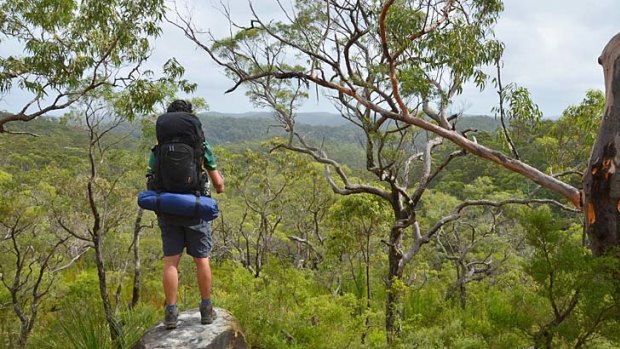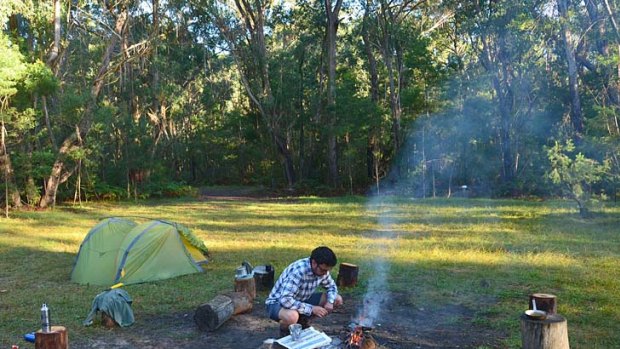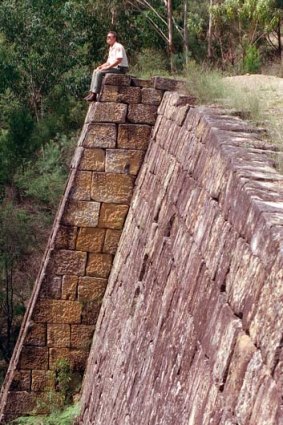
Views across Dharug National Park.Credit: Ben Stubbs
Ben Stubbs walks to Wisemans Ferry along the Convict Trail, a 43-kilometre remnant of mighty road works begun in the 1820s.
Lightning cracks above the ridge, illuminating the trees. The sky flashes again and I barely count to one before the sound of thunder rolls through the bush. We run for shelter, inside the long-drop loo enclosure at the camping ground.
No matter how experienced you are or how well you've planned a trip, sometimes things don't work out as you'd hoped. That's what we're telling ourselves as we press against the concrete floor of a bush toilet in the middle of the night.

Ten Mile Hollow camp.Credit: Ben Stubbs
My friend, Ben, and I are experienced trekkers; we're both fit and can read a map. Our plan is to walk the Convict Trail from Mogo Creek camping ground to Wisemans Ferry. This should mean a flat 22-kilometre stroll on day one and a 16-kilometre walk to finish on day two. A NSW National Parks and Wildlife Service ranger drops us at Mogo Creek. We just have to follow the trail to Wisemans Ferry, where our car is parked.
By the 1820s, Australia's settler population was spreading from central Sydney north towards the Hunter Valley. With water transport considered to be as yet unreliable, the colony's then governor, Ralph Darling, decided a road should be built to the Hunter. The task was assigned to newly arrived convicts and work on what is now known as the Great North Road began. This 264-kilometre road traverses ridges, cuts across sandstone cliffs and creates a path through bushland to the north-west of Sydney that at the time seemed otherwise impenetrable.
Construction lasted from 1826 until 1836. Scores of convicts chiselled and chipped at rock and manoeuvred 600-kilogram sandstone blocks, while wearing leg irons. It wasn't a practical route north for many travellers, however, and by 1832 many preferred to travel from Sydney by steamboat. By 1836 the road was all but abandoned. A 43-kilometre section remains reasonably well preserved. It's known as the Convict Trail and that is what we aim to walk.

Punishing... a convict-built sandstone retainingwall on the trail.Credit: Quentin Jones
Our topographical map is pretty clear. After an initial walk east for three kilometres, we should link with the Convict Trail that heads south with the certainty of a migrating bird. We adjust our 15-kilogram packs and follow a goat trail until we hit a T-intersection. This isn't on the map. We agree to turn right and our trail winds among corridors of thick bushland for an hour until we reach the crest of a small mountain that shouldn't be there.
We're lost, so we scale a ridge and look down through a funnel of foliage towards the Mangrove Creek Dam, which marks the trail and is where we should be. The descent is steep and rocky and our only option is to retrace our steps.
Spiders weave webs across the path and bull ants the size of AA batteries clamber at the edge of our socks as we inadvertently tramp across their homes. We finally come back to the intersection. This time we turn left and within a few hundred metres the wide, flat track of the Convict Trail confirms our mistake.

New South Wales' native flower, the waratah.Credit: Quentin Jones
This walk is a melancholy reminder of early settlement. My own ancestor, William Peat, worked as a gang supervisor on the road. While many Australians pay homage to their relatives at Gallipoli or on the Kokoda Track, this is my way to experience the trials of a forebear.
We continue along the flat track heading south past gnarled and thirsty trees and contrasting bright red and white wildflowers blooming in the brush. After hours of trekking along the ridges, we meet two mountain bike riders, the first people we've seen all day. We say we're going to camp at Ten Mile Hollow; they both raise eyebrows at our ambition. Grey clouds billow overhead and the humidity continues to suck every bead of moisture from us.
As we walk we see marks on cliff faces where convicts chipped out the road by hand, as well as remnants of the old bridges and gutters that so briefly serviced it.
The track narrows again and we take the left fork. It leads us down a winding hill and after two kilometres we realise our mistake and turn around again.
We have seven litres of water. Normally this would be fine, though as the kilometres we've walked extend to 32 in one day and the humidity soaks the moisture from our bodies, it becomes a problem. I can't enjoy the surroundings and the achievements of William Peat. I'm exhausted and thirsty. Darkness is falling and all I can do is place one foot in front of the other.
In the twilight, a fat grey snake slithers in front of us. I'm too tired to panic and I calmly walk around it, unwilling to break my rhythm.
The trail begins to descend and finally we see the expanse of Clare's Bridge. This grand example of the work the convicts put in is impressive, but my focus is only on the destination, so I skirt past the abutments and foundations of an old inn and stockade. In 1830, Solomon Wiseman built an inn here in anticipation of the hordes of thirsty travellers arriving, and a stockade was constructed to hold the more troublesome convicts. Only a few blocks remain and we tramp straight for the tap, in the absence of a pub, to rehydrate.
I drink five litres and still feel empty. We don't have a moment to waste, though, as the storm rolls in and we scuttle for shelter in that toilet. I have time, finally, to appreciate the harsh conditions the convicts must have endured on this road more than 180 years ago.
We're dehydrated, blistered and chafed, though this is just a weekend adventure. Later, when the rain stops and the moon comes out, we find dry wood for kindling and console ourselves with a campfire.
Next morning we are slow to get going. As our legs warm up, we pass the Wat Buddha Dhamma monastery built deep in the bush and see the cobblestones and graffiti etched by convicts on the trail.
We don't take any wrong turns today and slowly find our rhythm. A scattering of other trekkers and bike riders pass as we approach the final downhill run on Devines Hill to the ferry.
We're exhausted and a little frustrated at our wrong turns as we board the ferry across the Hawkesbury River.
Despite this, we have a real sense of achievement from walking 48 kilometres in two days and gaining a better understanding of the hardships William Peat and the hundreds of others on the Convict Trail must have experienced. It might look like a painful grimace from the outside, but we leave this region with smiles on our faces.
Ben Stubbs travelled courtesy of the NSW National Parks and Wildlife Service.
FAST FACTS
Getting there
Wisemans Ferry is 75 kilometres north of Sydney along the Old Northern Road. The Mogo Creek camping ground is accessible from Wollombi Road.
Walking the Convict Trail
It is suggested people walk the 43-kilometre trail in two to three days. All food and camping gear must be carried in. The Ten Mile Hollow camping ground has toilets and drinking water. Make sure you carry more water than you'll need if coming from Mogo Creek, as there are no potable sources along the way. See .
More information
See .
Sign up for the Traveller Deals newsletter
Get exclusive travel deals delivered straight to your inbox. Sign up now.